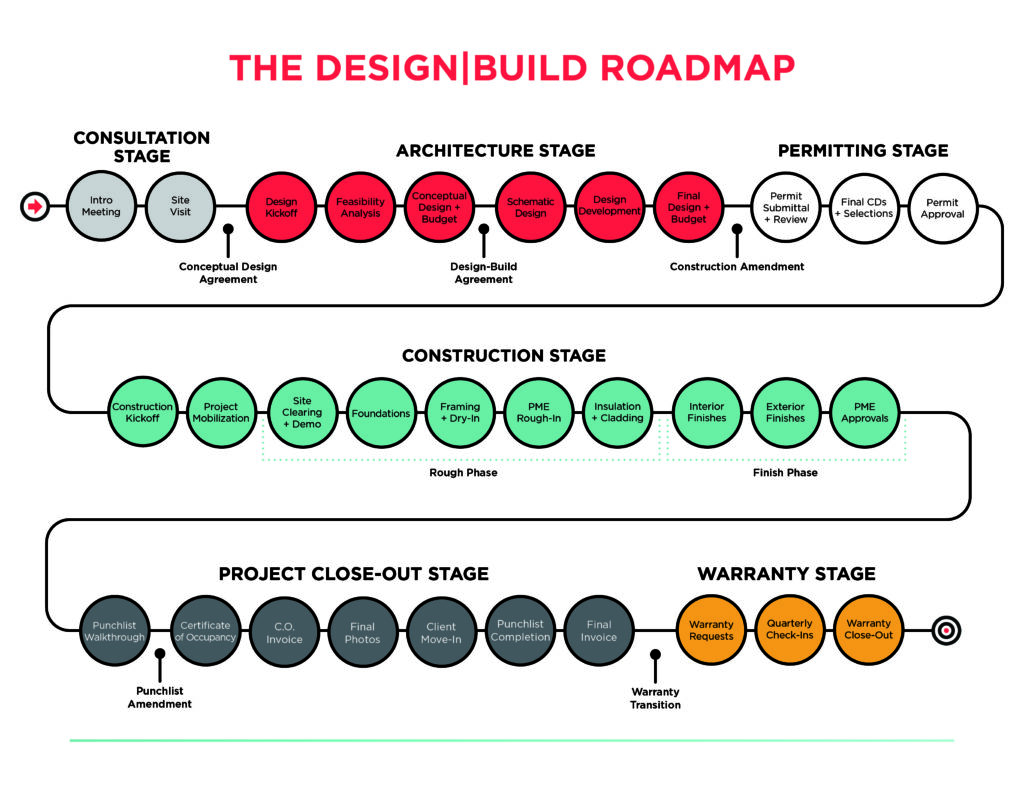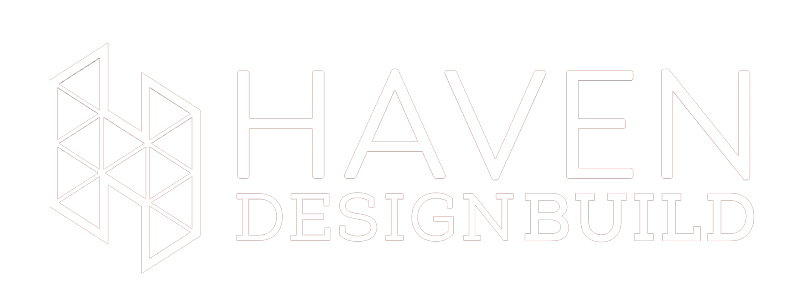Haven’s design-build approach offers key advantages over traditional project delivery. Typical (design-bid-build) projects, which have a separate designer and builder, experience schedule delays between phases and often require expensive and time consuming backtracking. Our clients experience a unified guide throughout the project without unnecessary delays or extra costs.
The Design|Build roadmap outlines key information about the entire design-build process, from start to finish, Haven’s staff work side-by-side with our clients to ensure nothing is missed and nobody is left behind. We frequently revisit this roadmap with our clients to review where we’ve been, where we are at, and where we are going. Decisions can be made at every point in time with a robust understanding of the end goal in mind. Haven is responsible for every stage of the process so that our clients can rest assured knowing we are their trusted expert.

The Consultation Stage
The consultation stage is our opportunity to meet a prospective client, to hear about their project goals, and to understand the constraints. It’s also when we share information about our firm and our process so that the client can make a fully informed decision on how to move forward with their project. The consultation stage culminates in a signed conceptual design agreement and an introduction to the Project Architect/Designer.
The Design Stage
The design stage is facilitated by the Project Architect/Designer (PA/D), who is responsible for guiding our clients through the entire design process. The design stage has numerous phases, starting with a kickoff meeting that is followed by subsequent bi-weekly project meetings.
The PA/D completes due diligence and feasibility studies on the site to determine what is possible, then moves into creating conceptual designs where the client’s vision begins to take shape. Conceptual design drawings are completed alongside a conceptual construction estimate so that the client can make budget informed decisions in order to settle on a design approach. The conceptual design phase leads to a signed design-build agreement which outlines the remainder of the process.
The schematic design and design development phases are where the project settles on a final design and begins defining all high level characteristics of the building, including the beginning parts of engineering. The construction document phase is the time where final details are elaborated upon and all necessary drawings for permits are created. Alongside construction drawings for permits is an updated final construction estimate. Once the final drawings and construction estimate are aligned with the clients vision, a construction amendment is signed in order to move forward into permitting.
The Permitting Stage
The permitting stage is a collaboration between the PA/D and the Construction Project Manager (CPM). Construction documents are submitted for permits, and the team responds to the municipality regarding and questions or comments. The project team also takes this time to finalize any further design details as well as finalizing specifications and selections with the client.
The Construction Stage
The construction stage is facilitated by the Construction Project Manager, who is responsible for guiding our clients through the entire construction process. This is the longest stage of the process, starting with a construction kickoff meeting followed by subsequent bi-weekly project meetings including the whole project team.
Throughout this entire construction process, the CPM manages the schedule and budget while ensuring the clients are constantly updated on progress. They are supported by Site Supervisors (SS) who are responsible for on-site quality control, safety, and cleanliness. The Project Architect/Designer remains lightly involved during this stage to ensure the client’s vision and goals are appropriately carried forward through the remainder of the process.
All construction activities that take place before project close-out fall into two phases, either the rough phase or the finish phase. The rough phase starts with project mobilization and includes the site preparation, foundations, framing, windows/doors, roofing, siding, and initial systems installation (plumbing, mechanical, electrical). The rough phase typically uncovers the most “unknowns” of the project and thus there are often many items for the project team to collaboratively resolve. The finish phase includes the final finishes of the project such as drywall, flooring, tile, paint, landscaping, and the final systems installation (plumbing, mechanical, electrical). Once the finishes are substantially complete, the project team has a walkthrough with the client to identify any outstanding items (the punchlist) while moving into the project close-out stage.
The Project Close-Out Stage
The project close-out stage includes the final portion of work during and immediately after the project is ready for occupancy. The project team continues in the same roles and responsibilities as throughout construction, with the CPM as the primary contact for the client.
Project close-out begins with receiving a Certificate of Occupancy (C.O.), the legal approval for the structure to be deemed ready for occupancy. During this time, the project will have marketing photos/videos taken, then be ready for the client to move into the space. The outstanding punchlist items are completed either prior to or within the first several weeks of the client moving into the space. Once the punchlist work is completed, the project transitions into the warranty stage.
The Warranty Stage
The warranty stage is a combination of Haven’s builder’s warranty 1-year period as well as the North Carolina based assumed builders warranty. During this stage, the project team will follow up periodically to check-in on the client and their project. Any covered warranty requests are resolved through the period and after which the project is completely closed-out.


